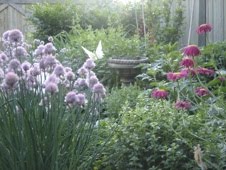 So, how is it possible to get from Tulip Time to late summer without a single blog entry? A simple equation explains this unexpected turn of events.
So, how is it possible to get from Tulip Time to late summer without a single blog entry? A simple equation explains this unexpected turn of events.Home renovations + an active seven-year old + a persistent throat infection and fatigue + a summer of giving tours in other people's gardens = the absentee blogger.
Remarkably, Blogger tells me gardeners have continued to check in through the blogging drought. For your patience, dear readers, thank you.
Despite the complete lack of entries, much has been happening in the garden. The garlic crop was incredible. Annuals were a bigger part of the garden than ever before. And, I've gone a bit conifer crazy. There has been a definite shift to more woody plants in both the full sun backyard garden and the shady woodland out front. Happily, there will be much to blog about in the cold months ahead.

I was coaxed out of my non-blogging stupor by colour. The closed gentians (gentiana clausa) began blooming a few days ago and the iridescent blue of the flowers caught my eye. The colour is very reminiscent of the Dwarf Iris "Cantab" which awakened the gardener in me in early spring.
 The gentians are planted amid the "Orange Queen" epimedium. Through careful garden design (also known as happy coincidence) the foliage of the epimedium and gentian are a nearly identical chartreuse colour. As a result, the taller gentian stems seem to emerge from the centre of the chartreuse epimedium carpet, almost as if the two plants were really one. This chartreuse futher provides an outstanding colour contrast to the blue gentian flowers.
The gentians are planted amid the "Orange Queen" epimedium. Through careful garden design (also known as happy coincidence) the foliage of the epimedium and gentian are a nearly identical chartreuse colour. As a result, the taller gentian stems seem to emerge from the centre of the chartreuse epimedium carpet, almost as if the two plants were really one. This chartreuse futher provides an outstanding colour contrast to the blue gentian flowers. I was so delighted to see these blue beauties this year. I was doubly delighted to discover that closed gentians blooms in tiers. Not only will you find a cluster of blooms at the end of the stem, but there are blooms that emerge from each whorl of leaves present on the stem. There are only a few secondary, tiered blooms this year. I expect the performance of the flowers will improve in subsequent summers. Their late summer bloom time is also appreciated. With the exception of the bugbane which is still to bloom, everything else in the garden faded long ago.
I was so delighted to see these blue beauties this year. I was doubly delighted to discover that closed gentians blooms in tiers. Not only will you find a cluster of blooms at the end of the stem, but there are blooms that emerge from each whorl of leaves present on the stem. There are only a few secondary, tiered blooms this year. I expect the performance of the flowers will improve in subsequent summers. Their late summer bloom time is also appreciated. With the exception of the bugbane which is still to bloom, everything else in the garden faded long ago. While researching gentiana clausa I learned that these North American natives are considered the flowers of wet meadows and woodlands. I have provided my gentians with some supplemental watering this summer. Even so, it has been very hot and dry. The gentians have taken their dry shade location in stride and appear to be content. I am happy to say that another impulse purchase has paid off.
While researching gentiana clausa I learned that these North American natives are considered the flowers of wet meadows and woodlands. I have provided my gentians with some supplemental watering this summer. Even so, it has been very hot and dry. The gentians have taken their dry shade location in stride and appear to be content. I am happy to say that another impulse purchase has paid off.
